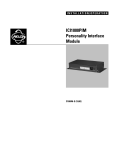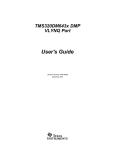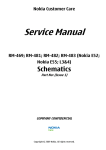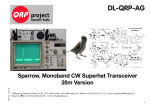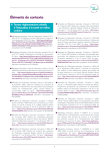Download CES 805 DTMF Service manual
Transcript
Model 805 DTMF Microphone Operation and Maintenance Manual 01100750 Revision B2 CES WIRELESS TECHNOLOGIES 931-218 South Semoran Blvd. Winter Park, Florida 32792 (407) 679-9440 June 6, 1994 Page 1 INTRODUCTION Your new CES Model 805 Universal DTMF Encoder Microphone is designed to provide superior and trouble free service. The 805 microphone can be used to dial DTMF telephone numbers from a mobile radio, in conjunction with a base station equipped with a telephone interconnect system. Model 805 features include: n Automatic transmitter keying n Automatic microphone muting while transmitting DTMF n Reliable all metal keyboard switches n Audible sidetone for verifying proper tone entry n Universal audio input matching allowing operation with any radio n Oversized twelve-key backlit silicon rubber keypad n High-impact, weighted, and ergonomically designed case for maximum durability n Integrated tactile PTT switch and case seal to exclude dust and moisture n Tone burst or continuous DTMF tone operation n Long-life durable coil cord The Model 805 is available with the following options: n Compatible mating connector installed for most popular two-way mobile radios. Contact your CES sales representative, dealer, or distributor about your requirement. n CTCSS Off-Hook Monitor logic for both open-circuit and closed circuit. Page 2 INSTALLATION The 805 Microphone requires 9VDC to 18VDC as a power source. If your 805 was shipped with a factory installed connector, then refer to the Application Note that is included, if any, for further instructions on modification of the radio to route this power source to the radio microphone connector jack. Some radio models have this power source already available and no modification is necessary. If your 805 was shipped with no connector installed, refer to Table 1. and wire a connector that mates with the radio microphone jack. Also refer to the radio service manual and schematic diagram for the appropriate connector pin number for each function. Table 1. - 805 Microphone Wiring Connections Cable Conductor Function Blue Red White Black Shield Yellow +12 VDC PTT (Push-To-Talk) TX Audio Input CTCSS Monitor Hang Up Audio Ground Power Ground Microphone Power Source Some transceivers will require a modification to bring a switched +9 to +18 VDC source voltage from the radio power switch or power regulator. This modification can easily be performed by a two-way radio technician. On most transceivers, a 'spare' or otherwise unused pin on the microphone jack is often available, such as a handset audio function. If using a pin that already has a functional purpose, ensure that this connection path or wire is disconnected from the microphone connector before routing the B+ source voltage for the 805 microphone. If the source pin to be used has a series resistor of more than 22 ohms, then bypass this resistor. After wiring the microphone connector, verify proper connections before applying power. Use an ohmmeter between the +12 VDC connection and ground(s) with and without the microphone connected. The resistance reading should not change appreciatively, and in particular should not show a low resistance reading with the microphone connected. If presence of alternator whine or other vehicular noise is apparent upon placing the 805 into service, remove the jumper JPR2 on the 805 printed circuit board. Refer to the Component Layout illustration for location of this jumper. Note: The 805 Series DTMF Microphones have been engineered to provide optimum performance with virtually all land mobile radio transceivers. However, if using the 805 with a radio that does not incorporate pre-emphasis (sometimes this is done in the original radio microphone) the resulting transmitted modulation will sound 'bassy'. If this is the case, then change the 805 audio output coupling capacitor C10 to .001 uF. If difficulty remains, contact CES Customer Service. Page 3 INSTALLATION - continued Continuous Tone Coded Squelch The 805 provides CTCSS or other tone decoder monitor or disable as a logical function that goes low or to ground whenever the microphone is placed on a grounded hang up clip. For applications that require a logical low or ground when the microphone is removed from the grounded hang up clip, contact the CES Sales Department. When installing the 805 microphone, ensure that the microphone hang up clip is properly grounded to the vehicle chassis (add a ground wire if necessary) if using CTCSS or other Tone Decoder hang up logic in the radio. Combined TX Audio and Other Functions For transceivers that require that the PTT signal is electrically sent from the microphone on the same wire connection as microphone audio, then install an appropriate resistor across jumper JPR3 on the 805 printed circuit board. Refer to the Component Layout illustration for location of this jumper. For the value of this resistor, refer to the original microphone circuit schematic diagram. For transceivers that require that CTCSS or other tone decoder hang function and microphone audio be sent on the same wire connection to the radio, install a resistor at R15 on the 805 printed circuit board. Refer to the Component Layout illustration for location of this jumper. On most radio models manufactured by Standard Communications the value of this resistor will be 8.2K ohms. MICROPHONE OUTPUT LEVEL MATCHING Before beginning to set output levels, consideration must be given to the type of microphone the radio uses and 805 jumper JPR1 (Refer to the Component Layout illustration for location of this jumper): Generally, JPR1 should be IN for radios using low impedance dynamic nonpreamplified microphones. Jumper JPR1 should be removed for radios that use microphones with an internal preamplifier. The 805 is shipped with jumper JPR1 in place, except for certain 805 application models where the jumper may already be removed for the specific radio type as ordered. VOICE AUDIO OUTPUT ADJUSTMENT Set up a communications service monitor on the transmitter frequency of a desired test or operational channel programmed into the radio. The use of an RF dummy load is recommended. Adjust the microphone potentiometer RV2 (accessible through the lower opening in the rear of the 805) while speaking in a normal voice so that the voice peaks just go into modulation limiting as observed on the service monitor oscilloscope. If the service monitor does not have an oscilloscope display, then it is suggested that the 'demod' output be connected to an oscilloscope. Page 4 INSTALLATION - continued DTMF TONE OUTPUT LEVEL With the service monitor set up as in the previous test: press a DTMF key on the 805 and adjust potentiometer RV1 (accessible through the upper opening) for 2/3 of the level that modulation limiting occurs as observed on the service monitor. For instance, if modulation limiting occurs at 5.0 KHZ, then set RV1 for a DTMF tone modulation of 3.3 KHz. If CTCSS tone is also being transmitted at the same time, set RV1 for a combined CTCSS + DTMF deviation of 4.0 KHz. Verify that the DTMF tones are not clipped or distorted as observed on the service monitor oscilloscope. For other system deviation limits, as in 2.5 KHz systems, utilize the same technique and 2/3 ratio in adjusting the DTMF and voice modulation levels . Location of Adjustments Once the DTMF and voice modulation adjustments have been completed, remove the backing from the rear panel label included and place the label over the potentiometer adjustment access area. Page 5 ADJUSTING TWIST The microphone generates two tones when any key on the keypad is depressed. The following table illustrates the row and column tones generated: Column Tones (Hz) Row Tones (Hz) 1209 1336 1477 697 1 2 3 770 4 5 6 852 7 8 9 941 * 0 # The actual frequencies generated are: Keypad Location Reference Tone (Hz) Actual Tone Output (Hz) Percent Deviation Row Tone 1 697 699.1 +0.30 Row Tone 2 770 766.2 -0.49 Row Tone 3 852 847.4 -0.54 Row Tone 4 941 948.0 +0.74 Column Tone 1 1209 1331.7 +0.57 Column Tone 2 1336 1331.7 -0.32 Column Tone 3 1477 1471.9 -0.35 DTMF twist is the ratio between the levels of the column tones and the row tones generated by any single keypad button. Because the higher frequency (column) tones are more readily attenuated than the lower frequency (row) tones, the high frequency tones of any DTMF pair are sent at a slightly higher level. The ratio of column/row tones is factory set to telephone industry standards and no adjustment is needed for most applications. However, if particular systems require levels other than the standard ratio, they can be adjusted. To increase the column/row ratio decrease the value of C4. To decrease the ratio, increase the value of C4. By generating the tones individually as a single tone, any adjustment of twist is made easier. This can be accomplished by temporarily the circuit board plating from U3 and ground. The burst mode jumper JPR4 must also be temporarily cut for single tone operation. A single row or column tone can now be generated by simultaneously pressing two keys in respective horizontal row or vertical column. Reinstall the jumpers as they were before when done. Page 6 JPR1 C6 C7 R25 JPR4 R12 Q3 CR5 U1 C15 CR6 C19 CR2 R16 CR3 C3 R1 R21 U4 C22 JPR2 P2 R23 R14 Q1 S1 L1 R22 R9 R20 J3 R10 È U5 C8 C18 R27 R28 Q4 Q2 U6 C14 È R19 R3 C9 C5 R8 R24 U2 C2 CR1 C16 C4 C20 R17 C10 U3 C13 C23 R29 R4 R5 È Q5 R7 C11 C17 R11 JPR3 R2 R18 R6 JPR5 R13 C21 R30 È CR4 C12 R26 RV2 RV1 Y1 < P1 R15 Page 7 DTMF BURST TONE MODE Model 805 microphones are shipped with the "Continuous Tone" mode enabled. To change to a "Burst Tone" mode, remove jumper JPR4 on the 805 printed circuit board. Refer to the Component Layout illustration for location of this jumper. When the 805 is in the Burst Tone mode, each time a key is depressed a burst of the applicable DTMF tone is generated for a period of 150 milliseconds, independent of how long the user holds the key depressed. This feature is provided, as some systems require this type of DTMF signalling. CIRCUIT DESCRIPTION Each time a key is depressed on the keypad the normally low output of U3 goes high, forward biasing CR2 and causing C19 to charge. The charge on C19 causes both inputs of U1C pins 8 and 9 to go high resulting in the output on pin 10 to go low. A low on either input of U1A results in a high output. With input pin 1 low, the output pin 3 will be high. This high is routed to pin 5 of U1B. When pins 5 and 6 of U1B are high, the output pin 4 of U1B will be low. This is tied to pin 2 of U1A. With a low on both outputs, pin 3 of U1A will stay high and the circuit is now latched, causing Q1 to conduct and turning on the sidetone audio amplifier. Pin 3 of U1A also causes CR5 to be forward biased which in turn causes Q2 and Q3 to conduct and automatically key the transmitter and illuminating the PTT LED. C19 will keep the circuit latched for approximately 1.5 seconds after each key has been pressed. This time delay allows the next key to be pressed before the transmitter is dropped. With jumper JPR4 in place, the tone generated will be a tone burst of approximately 150 ms per digit, regardless of how long the key is depressed. With this jumper removed, the tone will be sent for the duration of time that the key is depressed. To adjust the length of the tone burst, change the value of R16 (270K). A higher resistance will result in a longer tone burst length. The tone output goes from pin 16 of U3 through RV1 (the tone level adjustment), R1 and C5 to the level matching point at the junction of R8 and R24. The audio is then brought to the microphone output amplifier U4B pin 6. When a high level of audio output is required, jumper JPR1 is removed. This allows U3 to operate without negative feedback and raises the available audio level. RV1 adjusts the tone deviation level. C4 can be increased or decreased in value to change the column/row tone radio. When the PTT switch is pressed, manual keying with voice audio is activated. The PTT switch S1 connects R2 to +5VDC which causes Q4 to turn on, activating the microphone audio path through U4A. Pressing the PTT switch also causes CR6 to be forward biased that in turn causes Q2 and Q3 to conduct, automatically keying the transmitter and illuminating the PTT LED. Page 8 Model 805 Parts List Reference Description CES Part # Reference Description CES Part # C1 C2 C3 C8 C9 C17 C21 C4 C5 C6 C7 C13 C10 C11 C12 C15 C14 C19 C16 C18 C20 C22 C23* Capacitor 10 uf CE106 Capacitor .1 uf 50V Capacitor 470 pf Capacitor .01 uf Capacitor 220 pf Capacitor 2.2 uf NP Capacitor 22 pf Capacitor 1 uf Capacitor 10 pf Capacitor 1500 pf Capacitor 100 uf Capacitor 2700 pf Capacitor .047 uf Capacitor .001 uf CM.1 CM471 CM.01 CM221 CE2.2NP CM220 CT1 CT10 CM152 CE107 CM272 CM.047 CM.01 R16 R17 R18 R20 R21 R26 R22 R23 R24 R29* R15* R30* Resistor 270K Resistor 200K Resistor 1.5K Resistor 2.2K Resistor 560 ohm Resistor 8.2K Resistor 470 ohm Resistor 10K RC224 RC204 RC152 RC222 RC561 RC8.2K RC183 RC10K RV1 RV2 Potentiometer 100K Potentiometer 10K RV100K RV103 S1 Switch PTT MIC04-R CR1 CR2 CR3 CR5 CR6 CR4 Diode 1N5248 D5248 Diode 1N914 Diode 1N4749 D914 D4749 U1 U2 U3 U4 U5 U6 IC 4011 IC TDA7050 IC S2559E IC TL062 IC 5V Regulator U4011 U7050 U2559 U062 U78L05 Y1 Crystal 3.579 Mhz XTAL4 J2 2-Pin Connector CON53 non-ref items L1 Choke 10 mH CHOKE-2 P1 P2 Connector 14-pin Connector 6-pin CON02 CON54 Q1 Q2 Q3 Q5 Q4 Transistor MPSA13 FET VN10KM Transistor 2N2222 JFET J201 QA13 QVN10 Q2222 QJ201 R1 R4 R2 R3 R5 R19 R6 R25 R27 R7 R8 R9 R28 R10 R11 R12 R14 R13 Resistor 150K Resistor 47K Resistor 470 Resistor 47K Resistor 330 Resistor 100K Resistor 18 ohm Resistor 68K Resistor 10K Resistor 3.9K RC154 RC473 RC471 RC473 RC331 RC104 RC18R RC682 RC10K RC392 Front Case Half Rear Case Half H/Up Button Strap Weight, 80 grams Hang Up Button Screw, H/Up Button Rubber Gasket PTT Button Plate Case Screw Silicon Keypad Bezel PTT Button Spring Electric Microphone Speaker 1.5" 8 ohm PTT LED Red Rear Label, 805 Microphone Cord Flex Strip MIC04-A MIC04-B MIC04-C MIC04-D MIC04-E MIC04-F MIC04-G MIC04-H MIC04-K MIC04-T MIC04-U MIC04-N MIC04-Q MIC04-S LED4 LABEL016 CRDMIC-2** FLEX1 Notes: * These components apply only to optional 805 circuit functions such as CTCSS Inverter, etc. **Microphone cord part number shown is for anunterminated coil cord assembly (no connector). Limited Warranty CES WIRELESS TECHNOLOGIES (CES) warrants this product to be free of defect in material and workmanship and extends this warranty under intended use and normal service conditions to the original owner for a period of one year from the date of purchase. This warranty does not apply to any product that has been subjected to repairs or alteration not authorized by CES, or for any product that has been damaged due to accident, abuse, neglect, vandalism, loss, unreasonable use, improper installations, lightning, fire, or water damage. The obligations of CES are limited to repairing or replacing, at the option of CES, any product or component that is returned to the factory all transportation charges prepaid, accompanied by proof of purchase and which examination reveals to have been defective within the warranty period stated above. CES does not assume, nor is any person authorized to assume for it, any obligation other than that stated herein. Any implied warranties, including but not limited to fitness for a particular purpose, are limited in duration for the above one year period. CES shall not be liable under this warranty, or any implied warranty, for the loss of use of the product or for any other consequential loss or damage incurred by the purchaser. Some states do not allow the exclusion or limitation of implied warranties or consequential damages and so the above exclusions or limitations may not apply. This warranty gives you special legal rights and you may have other rights that vary from state to state.













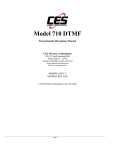

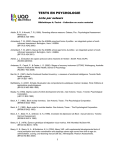


![Trace Elliot V4[1]](http://vs1.manualzilla.com/store/data/006017218_1-da9c5d9940e3b4825dbcd5847480f1a7-150x150.png)

